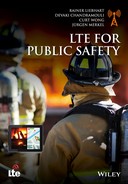Introduction
In a nutshell, this book explains how Long-Term Evolution (LTE) can be used as technology enabler for Public Safety networks, for example, how Public Safety networks can be built on top of LTE. We use the term LTE as synonym for the overall system that consists of radio and core networks, also known as Evolved Packet System (EPS). As a prerequisite, the book assumes some familiarity of the reader with basic concepts of mobile networks and especially with LTE. In Chapters 1 and 2, the book starts with an overview of LTE, its history, network architecture, and main features. Readers interested in detailed call flows for basic procedures should have a look into the Appendix. Chapters 1 and 2 are self-explanatory, but by nature they are not intending to give a full and complete overview of LTE. Hints for further reading, for example, consulting 3GPP specifications, are provided in the various chapters of the book. After reading Chapter 1, the reader should have a fairly good understanding of and why LTE was developed, knows the main architectural alternatives and used interfaces, knows the purpose of mobility management procedures, the LTE QoS concept, the purpose of bearers in LTE, and how they are established and has an understanding of LTE security. In addition, Chapter 1 describes features like Voice/SMS in LTE Multicast Broadcast Multimedia System (MBMS) and Network Sharing that are directly or indirectly of relevance for Public Safety.
Focus of Chapter 2 is on regulatory features and priority services available in LTE. These include support for emergency services, support for public warning messages, lawful intercept, and enhanced multimedia priority service. As these features are potentially important also in case of Public Safety networks, we provide an overview in this chapter. Chapters 1 and 2 should give the reader a good understanding of the feature-richness of the LTE standard.
While Chapter 3 explains the special nature of Public Safety networks and why LTE was chosen as technology for next-generation Public Safety networks, Chapters 4 and 5 are at the heart of this book. Chapter 4 describes so-called Proximity Services and their impacts on LTE radio and system design. This feature enables two LTE devices to discover each other and directly communicate, that is, communicate without network coverage. Thus, it introduces a fundamentally new form of communication using the standardized LTE technology as up to now two LTE devices can only communicate using the network.
Chapter 5 explains how a group communication service on top of LTE can be implemented. Efficient communication within a group of devices is, apart from device-to-device communication, the second important service in a Public Safety network. Group communication in this respect deals with all aspects of providing the same content to many LTE devices at the same time. This service is mainly used by “Push to Talk (PTT)” applications where one group member talks at a certain time and the content is distributed to all other group members. Chapter 5 requires some knowledge about MBMS that is provided in Chapter 1. The application using such capabilities is up to now not specified in 3GPP or other organizations. However, 3GPP has started working on a so-called Mission Critical Push to Talk (MCPTT) application in its Release 13.
In Chapter 6, we give some hints about our expectations of this recently started activity on MCPTT. In addition, Chapter 6 explains why we think LTE was the right choice as technology for future Public Safety networks and gives an outlook to upcoming work in 3GPP.
Finally, the Appendix provides details for the most important call flows regarding mobility management, session management, MBMS procedures, and an overview of 3GPP reference points used throughout the book.
